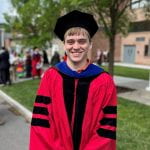We’re looking for a postdoc working on Short-Pulse Fiber Lasers. Please see the Opportunities page for detail.
Gallery Archives
Yi-Hao_LWIR
Femtosecond long-wave-infrared generation in hydrogen-filled hollow-core fiber
This paper is chosen as Spotlight on Optics.
Generating femtosecond long-wave-infrared (LWIR) pulses is currently restricted to CO2 lasers and solid-state frequency converters, but waveguide-based Raman red shifting offers a promising alternative. In this study, we used a hydrogen-filled hollow-core fiber to generate LWIR pulses and found that a waveguide structure allows for tailored Raman gain. Using a two-pulse scheme with a two-color source, we achieved a numerical generation of clean 88-fs pulses at 12 μm with 41% total quantum efficiency. Our simulations also shed light on the nonlinear dynamics of the Raman gain, emphasizing the importance of a phonon amplifier for optimal performance.
In this work, especially its supplemental document, we have provided a complete introduction to the gas nonlinearity and its modeling detail. Please read it if you’re interested.
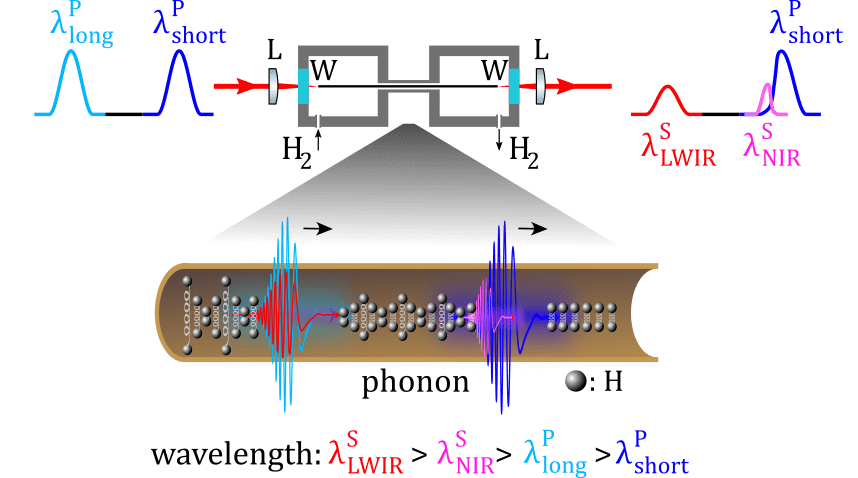
Yuhang Wu_AnomalousBC
Beam self-cleaning of femtosecond pulses in the anomalous dispersion regime
Kerr beam cleaning in graded-index multimode fiber has been investigated in experiments with sub-nanosecond pulses and in experiments with femtosecond pulses at wavelengths where the dispersion is normal. We report a theoretical and experimental study of this effect with femtosecond pulses and anomalous dispersion. In this regime, beam-cleaning is observed experimentally. Beyond the spatial dynamics, with the increase of input pulse energy, there is a strong temporal self-compression of the pulse from 500 fs down to around 30 fs (a factor of 17). Numerical simulations exhibit the qualitative trends of the experiments. Our study provides a way to enhance beam quality and temporal peak power at the same time in graded-index multimode fiber and the anomalous dispersion regime.
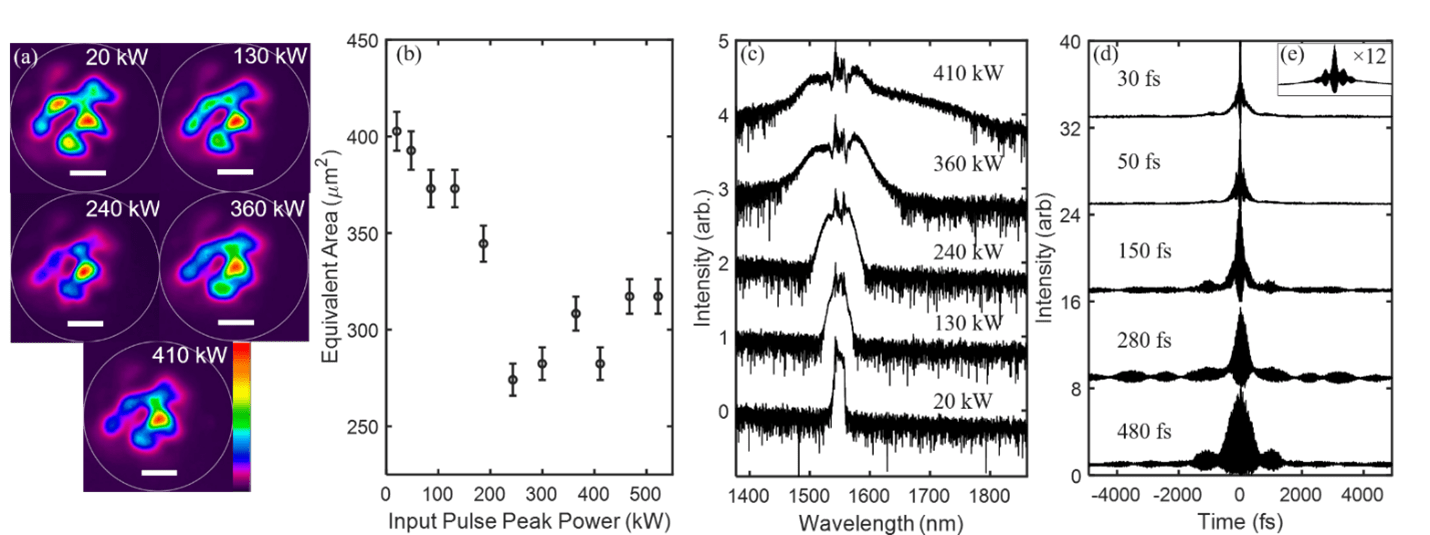
Yi-Hao_SSFS
Efficient soliton self-frequency shift in hydrogen-filled hollow-core fiber
SSFS has been considered as a good option for fiber sources with tunable wavelengths for a long time. Particularly, nonlinear microscopy, such as three-photon imaging, requires high peak power at 1300 and 1700 nm to overcome the depth limit of two-photon imaging. During the process, the Raman soliton gradually shifts towards the red color as it moves forward. Although several methods have been utilized to achieve these wavelengths, it seems challenging to increase the pulse energy in solid-glass fibers. Here, we have shown that SSFS can occur efficiently and cleanly in a hydrogen-filled anti-resonant hollow-core fiber. By using hydrogen and short input pulses, we have demonstrated continuous tuning of the wavelength between 1080 and 1600 nm. We have obtained pulse energies in the range of 20 to 110 nJ and durations below 50 fs over this spectral range.
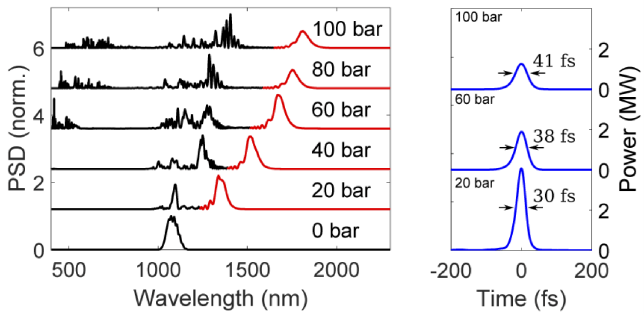
Henry_MMMamyshev
Multimode Mamyshev oscillator
Regular mode-locked lasers make short light pulses by synchronization or “locking” of many longitudinal cavity modes. It was recently shown that the transverse modes of a cavity can also be synchronized in a similar— but more general— form of mode-locking known as “spatiotemporal mode-locking” (STML). These lasers make ultrafast pulses that have spatial structure due to the many transverse modes involved. Understanding of this phenomenally complex phenomenon is limited: STML has so far been demonstrated a handful of times in relatively similar types of multimode fiber lasers. In this project, we study STML in a very different type of cavity architecture— the Mamyshev oscillator. The laser supports a vast array of mode-locked states. Learning to control these states in a meaningful way is a long-term goal which might enable gigawatt-class fiber lasers, or fiber lasers that generate purposefully-structured light for applications.
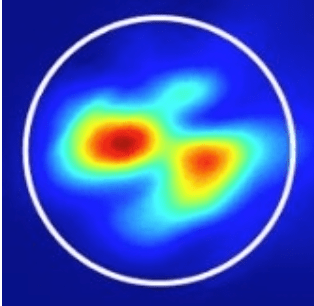
Henry_AllFiberMamyshev
Megawatt pulses from an all-fiber and self-starting femtosecond oscillator
Mamyshev Oscillators are a relatively new type of fiber laser with extraordinary pulse performance— these lasers generate the highest peak-power pulses from femtosecond fiber lasers by over a factor of 10. Mamyshev oscillators should be excellent tools for applications like microscopy and micromachining, but there’s a catch: most Mamyshev oscillators are impractical for applications outside laser labs since they need another mode-locked laser to start and are relatively complicated and expensive. In this project we designed a Mamyshev oscillator that solves these practical problems and comes in a totally fiber-integrated, ready-for-applications format. The laser generates pulses on par with those from much more complex Mamyshev oscillators, and remarkably starts with some simple electronics rather than an additional mode-locked laser. The pulse energy (80 nJ) and duration (40 fs) advances the state-of-the-art for all-fiber, self-starting lasers by 20x, and should be scalable by another factor of 5 with large-mode-area fiber.
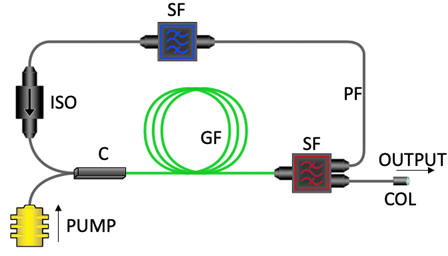
vOPCPA
Femtosecond optical parametric chirped-pulse amplification in birefringent step-index fiber
While optical fiber is convenient for many applications, generating short pulses outside of the typical gain bandwidth of rare-earth dopants commonly used in fiber amplifiers and oscillators is challenging. There are relatively few dopants that are compatible with the silica glass host, which leads to significant spectral gaps in which it is difficult to generate strong ultrashort pulses. It is sometimes possible to use nonlinear wavelength conversion to generate pulses in these spectral gaps, however. Parametric amplification conveniently generates two sidebands simultaneously, though to this point compressed pulse durations have been limited to ~200 fs and non-standard fiber waveguide geometries have been necessarily employed in order to achieve phase-matching. In this work, we demonstrate optical parametric chirped-pulse amplification in commercially available birefringent step-index optical fiber, delivering tens-of-nanojoule pulses compressible to 60-70 fs at 900 nm and 1270 nm. The key advances in this work were using birefringence rather than dispersion engineering in order to achieve phase-matching, and furthermore realizing that pumping the system with an extremely broadband pulse (from a gain-managed nonlinear amplifier) would allow the generation of energetic pulses compressible to very short duration. In addition, as the amplifier works with chirped pulses, we believe that the pulse energy may further be increased by chirping the pulses to longer duration and/or by employing large-mode area fiber for parametric amplification. We plan to use this system for hyperspectral degenerate and non-degenerate two-photon excitation fluorescence microscopy in the near future, enabling studies of complex biological processes in vivo.
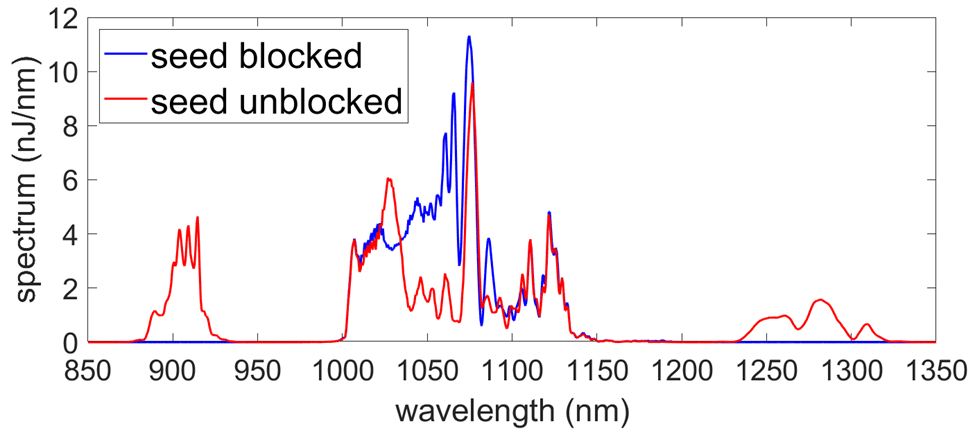
Michael_Graduate
Yi-Hao Chen_JOSAB award
3/23/2022 – Congratulations to Yi-Hao Chen on being selected as the winner of the 2021 JOSA B Emerging Researcher Best Paper Prize!
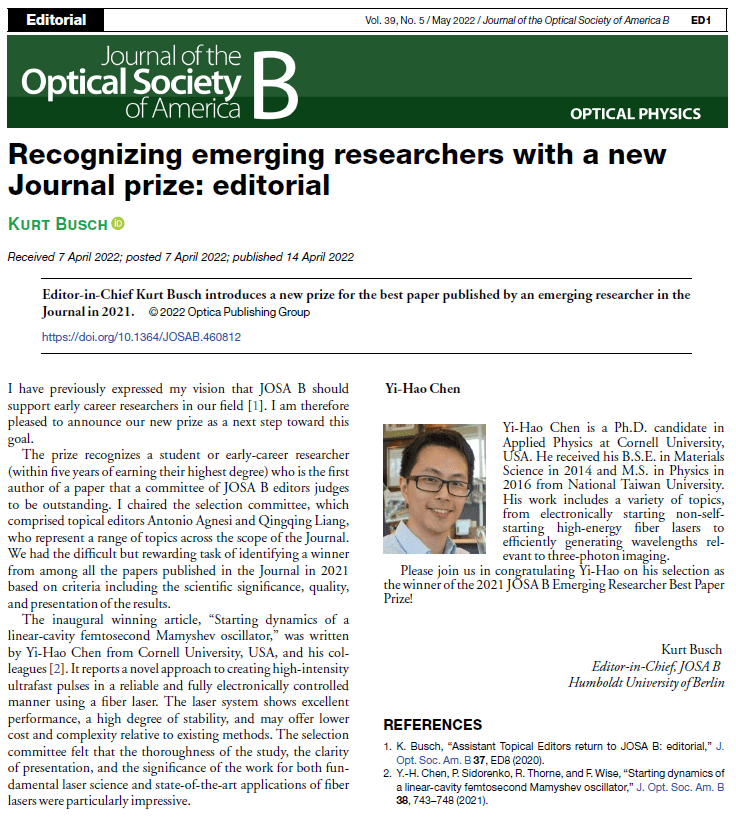
Starting Dynamics of Linear Mamyshev Oscillator
Starting dynamics of a linear-cavity femtosecond Mamyshev oscillator
This paper is chosen as Spotlight on Optics.
Mamyshev oscillator is a laser that not only generates strong pulses but is also capable of maintaining environmental stability. However, starting becomes a challenge due to the suppression of noise from continuous-wave (CW) lasing. Solutions to starting are to start with an external seed pulse, overlapped filter passbands to allow CW lasing, or self-seeding with a NPE starting arm described by Pavel et al. Here we proposed another solution to starting with pump modulation. It requires no mechanical flipping such as self-seeding and is demonstrated with full electronic control (Please watch the demonstration video here). Furthermore, it is demonstrated to reach a higher pulse energy by later increasing the filter separation. The laser is found to start reliably with pump modulation of a high repetition rate (>70 kHz) due to the emergence of a modulated mode-locked state. Besides, we found that damage from SBS constantly occurred in a linear cavity such that adding Faraday rotators is required.

